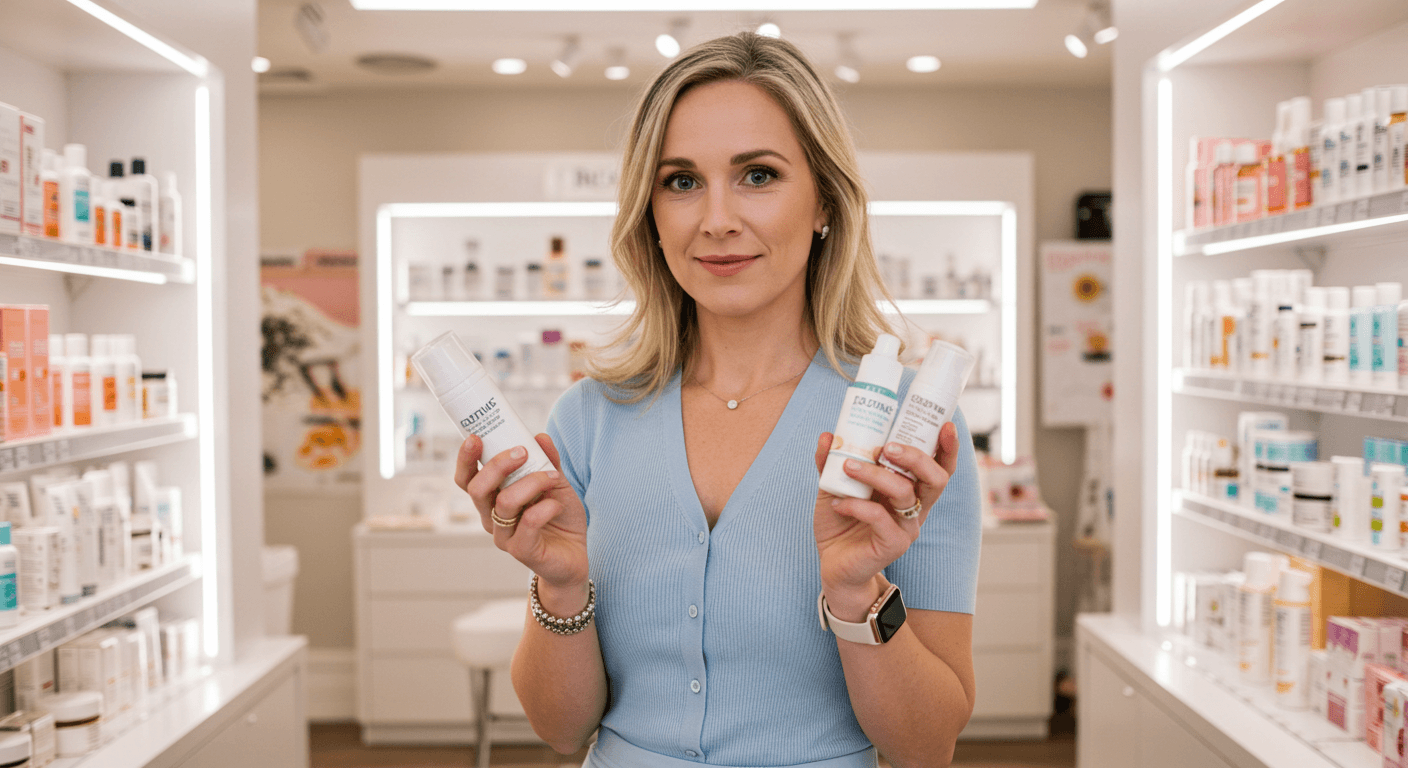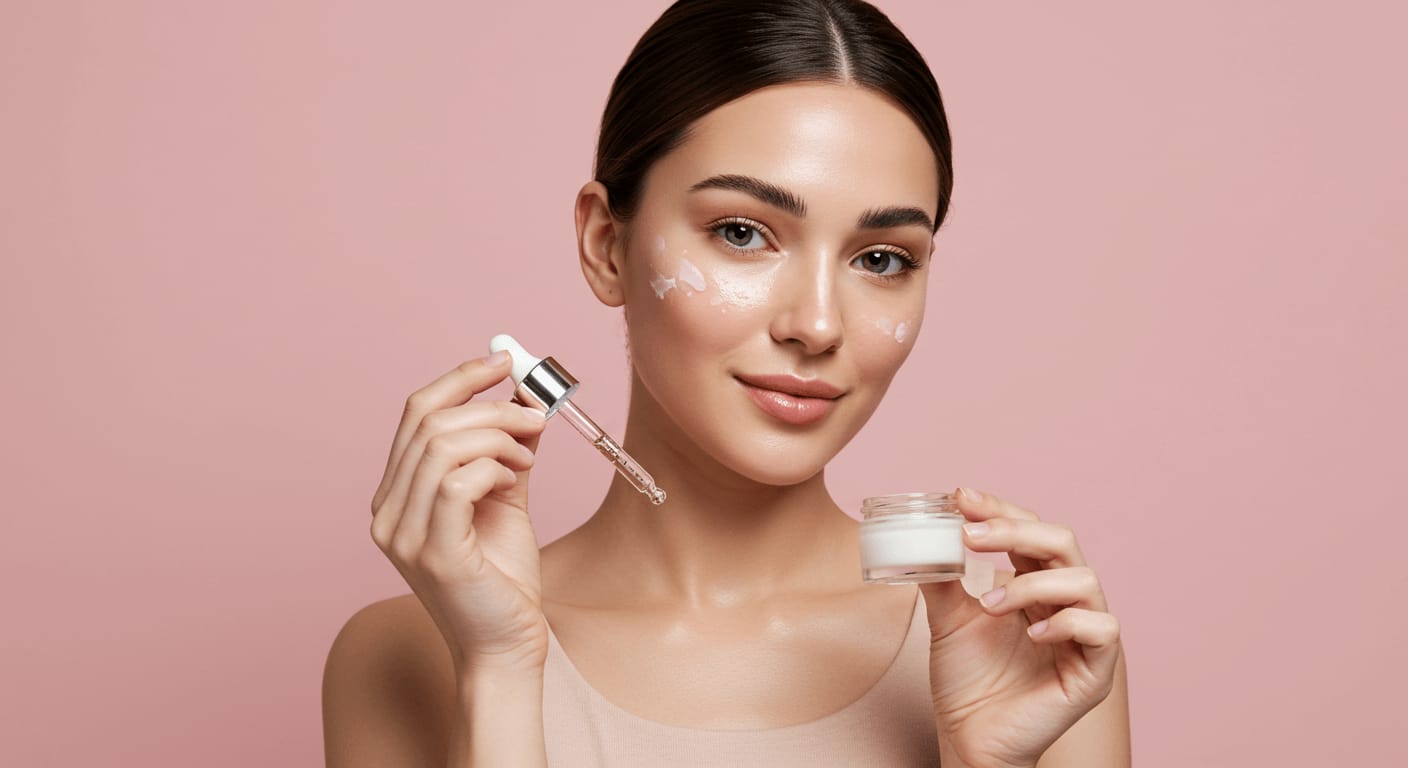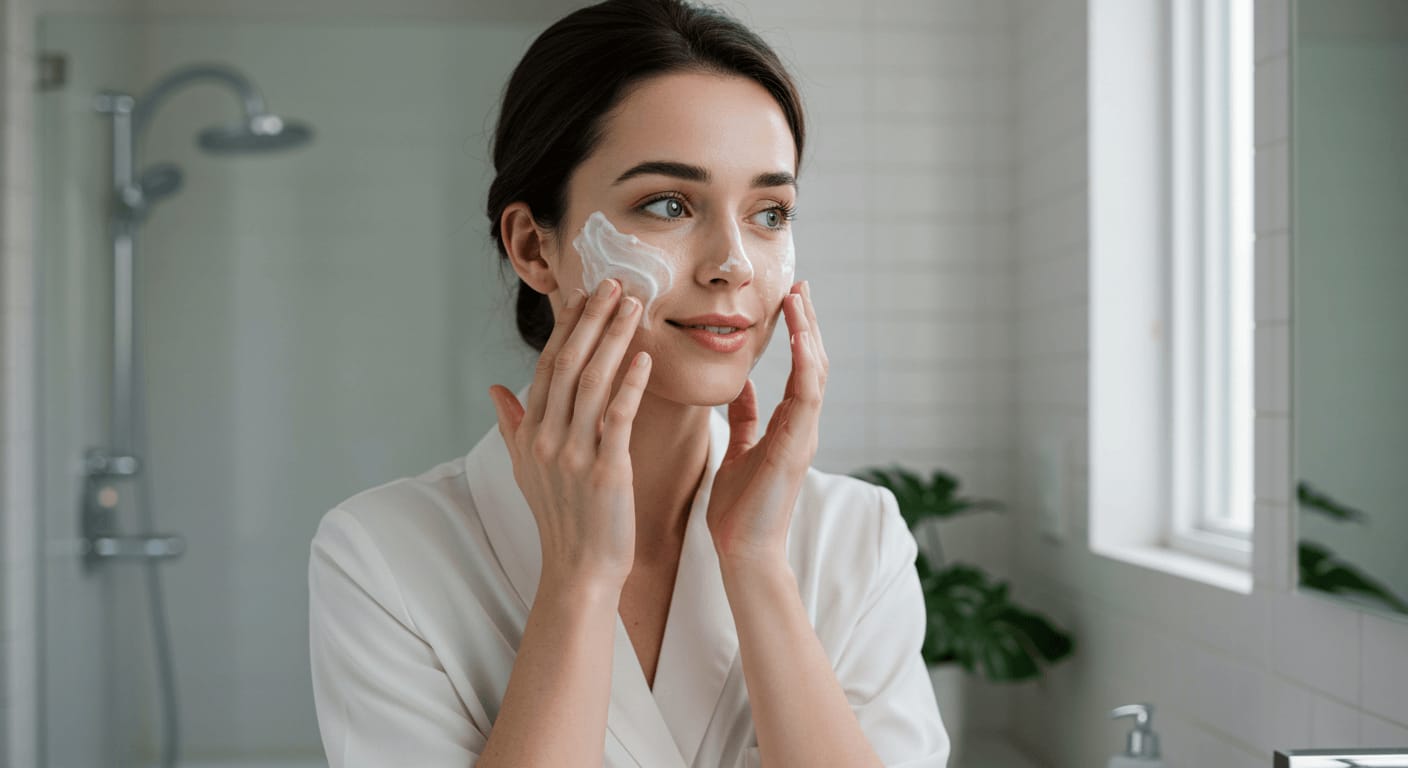As you step out into the polluted air, your skin is exposed to harmful toxins that can cause premature aging. But don’t worry, you can fight back with a solid skincare routine! You deserve to have glowing, healthy skin, despite the damaging effects of the environment. By following the right steps, you can protect your skin from harmful UV rays and toxic pollutants, and achieve the radiant complexion you’ve always wanted. Get ready to give your skin the protection it needs!
Table of Contents
Key Takeaways: Steps For A Skincare Routine To Combat Environmental Damage
To establish an effective skincare routine that combats environmental damage, consider the following points:
- Start with a gentle cleanser that effectively removes impurities without stripping the skin of its natural oils, allowing it to maintain its barrier function against environmental stressors.
- Use a toner that balances the skin’s pH and prepares it for further products, helping to minimize the impact of pollution and other environmental factors.
- Incorporate an antioxidant serum to neutralize free radicals caused by exposure to UV radiation, smoke, and other pollutants, thereby reducing oxidative stress.
- Apply a moisturizer that provides hydration and helps repair the skin’s barrier, protecting it from dehydration and damage caused by cold winds, dry air, and other environmental elements.
- Utilize a sunscreen with a high SPF as part of your daily routine, even on cloudy days, to shield your skin from harmful UV rays that contribute to premature aging and skin damage.
- Exfoliate regularly to remove dead skin cells and improve skin texture, but be gentle to avoid causing micro-tears that can make the skin more susceptible to environmental damage.
- Stay hydrated by drinking plenty of water to help your skin maintain its elasticity and resilience against environmental stressors from the inside out.
Understanding Environmental Damage
The first step in combating environmental damage to your skin is to understand what it is and how it affects you. You are constantly exposed to various environmental stressors that can cause damage to your skin, leading to issues such as premature aging, hyperpigmentation, and dehydration. If you want to protect your skin, you need to know what you’re up against.

Types of environmental stressors affecting skin
You are surrounded by pollution, UV radiation, and smog that can wreak havoc on your skin. Here are some of the most common types of environmental stressors:
- Air pollution: exposure to particulate matter, nitrogen dioxide, and other pollutants
- UV radiation: exposure to UVA and UVB rays from the sun or tanning beds
- Smog: exposure to ground-level ozone and other atmospheric pollutants
- Water pollution: exposure to chemicals and heavy metals in water
- Climate change: exposure to extreme temperatures, humidity, and weather conditions
Any skincare routine should take these factors into account to be effective.
If you’re looking for a way to understand the impact of environmental stressors on your skin, consider the following table:
| Environmental Stressor | Effect on Skin |
|---|---|
| Pollution | Premature aging, inflammation |
| UV radiation | Photoaging, skin cancer |
| Smog | Dehydration, irritation |
| Water pollution | Toxicity, skin conditions |
| Climate change | Extreme weather conditions, skin sensitivity |
Factors contributing to skin damage
Understanding the factors that contribute to skin damage is key to developing an effective skincare routine. You should consider the following factors:
- Genetics: your genetic predisposition to certain skin conditions
- Lifestyle: your diet, stress levels, and sleep habits
- Environment: your exposure to environmental stressors
Recognizing these factors will help you create a personalized skincare routine that addresses your specific needs.
A thorough understanding of the factors contributing to skin damage is vital for developing a successful skincare routine. You should also consider the following factors:
- Hormonal changes: fluctuations in hormone levels that can affect your skin
- Medications: certain medications that can have negative effects on your skin
- Skincare products: the quality and efficacy of your skincare products
Recognizing these factors will help you make <strong=informed decisions about your skincare routine and ensure that you’re giving your skin the best possible care.
Preparing for a Skincare Routine
Some people may think that starting a skincare routine is as simple as just washing your face and applying a moisturizer, but effective skincare requires a bit more effort. To tackle environmental damage, you need to be consistent and patient. When you’re getting ready to start your skincare journey, it’s important to set goals and understand what you want to achieve. This will help you create a routine that’s tailored to your skin type and concerns. You’ll also want to educate yourself on the different types of products and ingredients that will help combat pollution and UV damage. The key to a successful routine is finding products that work for you and sticking to it.

Essential tips for a beginner-friendly routine
- Start with a gentle cleanser that won’t strip your skin of its natural oils
- Use a toner to balance your skin’s pH and tighten pores
- Apply a moisturizer that suits your skin type to lock in hydration
You should also be aware of common mistakes that can hinder your progress, such as over-exfoliating or using too many products at once. The most important thing is to listen to your skin and adjust your routine accordingly, and be patient as you work towards your skincare goals. The road to achieving healthy, glowing skin is a long one, but with the right mindset and products, you’ll be on your way to combating environmental damage in no time.
Setting realistic expectations
Skincare is a journey, not a quick fix. It takes time and effort to see results, so it’s important to be realistic about what you can achieve. You won’t wake up with perfect skin overnight, but with consistent effort, you can make significant progress. Preparing your skin for the challenges of environmental stressors is an ongoing process that requires dedication and commitment. As you work towards your skincare goals, celebrate small victories along the way, and don’t be too hard on yourself if you encounter setbacks. The key to success is finding a routine that works for you and sticking to it, and stay positive as you work towards achieving your skincare goals.
Step-by-Step Skincare Guide
To get started with your skincare routine, you’ll want to break it down into manageable steps. Here’s a simple outline to follow:
| Step | Action |
|---|---|
| 1 | Cleanse your face with a gentle cleanser |
| 2 | Apply a toner to balance your skin’s pH |
| 3 | Apply a serum to target specific skin concerns |
| 4 | Moisturize with a hydration-rich cream |
You’ll want to tailor your routine to your individual skin type and concerns, but this will give you a solid foundation to work from.
As you go about your day, your skin is exposed to harsh environmental stressors like pollution, UV rays, and dry air, which can cause premature aging and skin damage. To combat this, you’ll want to establish a consistent skincare routine that includes both morning and nighttime steps.

Morning routine to combat daily damage
Mornings are all about prepping your skin for the day ahead. You’ll want to start with a gentle cleanser that won’t strip your skin of its natural oils, followed by a lightweight moisturizer that will help lock in hydration and protect your skin from the elements. Don’t forget to apply a broad-spectrum sunscreen with at least SPF 30 to prevent UV damage.
By following these simple steps, you can help shield your skin from the harmful effects of the environment and keep your complexion looking healthy and radiant.
Nighttime routine for repair and rejuvenation
Repairing is all about giving your skin the tools it needs to recover from the day’s damage. At night, you’ll want to double-cleanse your face to remove all makeup and impurities, followed by a toner and a serum that contains active ingredients like retinol or peptides. Finish off with a rich moisturizer that will help lock in all the good stuff and support skin regeneration.
StepbyStep, you’ll want to pay close attention to your skin’s unique needs and adjust your routine accordingly. If you have acne-prone skin, you may want to use a spot treatment containing salicylic acid or benzoyl peroxide to help control breakouts. If you have dry or sensitive skin, you may want to use a soothing mask once or twice a week to help calm and hydrate your skin. By taking the time to customize your routine, you can help your skin look and feel its absolute best.
Choosing the Right Products
Now that you’re on the path to creating a skincare routine to combat environmental damage, it’s time to think about the products you’ll be using. You’ll want to choose products that not only protect your skin from the outside in, but also promote overall skin health. With so many options available, it can be overwhelming to decide what to use. Let’s break down the pros and cons of natural and chemical-based skincare products to help you make an informed decision.
Your skincare journey is all about finding the right balance, and that starts with understanding the products you’re putting on your skin. As you explore into the world of skincare, you’ll come across a multitude of options, each with its own set of benefits and drawbacks. To help you navigate this complex world, let’s take a closer look at the pros and cons of natural and chemical-based skincare products.

Pros and cons of natural skincare products
You will likely encounter a plethora of natural skincare products on your journey, each with its own unique set of benefits and drawbacks. The following table outlines some of the key points to consider:
| Pros | Cons |
|---|---|
| Gentle on skin | May not be as effective for severe skin issues |
| Natural ingredients | Can be expensive |
| Less likely to cause irritation | May have a shorter shelf life |
| Environmentally friendly | Not regulated by the FDA |
| Customizable | May interact with other products |
As you can see, natural skincare products have a lot to offer, but they may not be the best choice for everyone, especially those with severe skin issues.
Pros and cons of chemical-based skincare products
The truth is, chemical-based skincare products can be a bit of a double-edged sword. On the one hand, they can be very effective at addressing specific skin concerns, but on the other hand, they can also have some serious drawbacks. The following table outlines some of the key points to consider:
| Pros | Cons |
|---|---|
| Fast and effective results | Can be harsh on skin |
| Regulated by the FDA | May contain harmful ingredients |
| Affordable | Can have negative environmental impact |
| Wide range of options | May interact with other medications |
| Scientifically backed | Can be addictive |
As you consider your options, keep in mind that chemical-based skincare products can be very effective, but they can also have some serious side effects.
Another thing to consider when looking at chemical-based skincare products is the potential for long-term damage. While they may provide quick results, they can also have lasting negative effects on your skin and the environment. The following table outlines some additional points to consider:
| Pros | Cons |
|---|---|
| Convenient | May contain toxic ingredients |
| Easily accessible | Can be bad for sensitive skin |
| Backed by scientific evidence | May have unpleasant side effects |
As you weigh your options, be sure to prioritize your skin health and consider the potential risks and benefits of each product.
Lifestyle Changes for Enhanced Skincare
Keep in mind that your skincare routine is not just about the products you use, but also about the lifestyle choices you make. You have the power to protect your skin from environmental damage by making a few simple changes. For instance, you can start by reducing your exposure to pollution and UV rays, which can cause premature aging and skin cancer. Clearly, taking care of your skin requires a holistic approach that involves both internal and external factors.
Obviously, maintaining a healthy lifestyle is key to achieving glowing and healthy skin. You can start by making conscious choices about your diet and stress levels.

Dietary tips to support skin health
Keep in mind that what you eat has a significant impact on your skin health. You can support your skin by consuming a diet rich in antioxidants, omega-3 fatty acids, and vitamins. Here are some dietary tips to help you get started:
- Eat foods high in antioxidants such as berries, leafy greens, and other fruits and vegetables
- Incorporate omega-3 rich foods like salmon, walnuts, and chia seeds into your diet
- Stay hydrated by drinking plenty of water throughout the day
You can make a significant difference in your skin health by making these simple dietary changes. Recognizing the importance of diet in skincare will help you make informed choices about what you eat.
Managing stress for better skin
The key to managing stress is to find healthy ways to cope with it, as chronic stress can lead to inflammation and skin issues. The best way to manage stress is to engage in activities that bring you joy and help you relax, such as meditation, yoga, or reading.
Skin that is well-cared for is not just a result of a good skincare routine, but also a result of a healthy lifestyle. The most important thing you can do for your skin is to reduce stress and get enough sleep, as these can have a significant impact on your overall skin health, causing acne, dark circles, and fine lines.
Maintaining Consistency and Patience
After you’ve established your skincare routine, it’s crucial to stick to it and be patient. Consistency is key to seeing real results and combating environmental damage. You’ll need to make skincare a non-negotiable part of your daily routine, like brushing your teeth or taking a shower. It may take some time to notice improvements, but persistency will pay off in the long run. As you continue with your routine, you’ll start to notice positive changes in your skin, such as a smoother texture and a more even tone.
As you progress, you’ll need to fine-tune your routine to address any concerns that arise. This is where tracking your progress comes in handy. By keeping tabs on how your skin responds to different products and treatments, you’ll be able to make informed decisions about what works best for you. This might involve adjusting your product usage or switching to new products that better suit your skin type. Don’t be discouraged if you encounter setbacks – instead, use them as opportunities to learn and grow.

Tracking progress and adjusting the routine
There’s no one-size-fits-all approach to skincare, and what works for someone else may not work for you. You’ll need to pay attention to your skin’s unique needs and make adjustments accordingly. This might involve keeping a skincare journal to track your progress, note any changes, and identify patterns. By doing so, you’ll be able to refine your routine and make data-driven decisions about your skincare. Don’t be afraid to try new products or seek advice from a dermatologist if you’re unsure about what to do.
There’s a delicate balance to maintaining a consistent skincare routine. You’ll need to find a balance between being consistent and being flexible. As your skin changes and evolves, your routine may need to evolve with it. By staying attentive and adaptable, you’ll be able to stay on top of your skin health and make informed decisions about your skincare routine.
Overcoming common skincare challenges
Adjusting to a new skincare routine can be challenging, especially when faced with common issues like acne, hyper-pigmentation, or dryness. You may need to experiment with different products or techniques to find what works best for your skin. Don’t be discouraged if you encounter setbacks – instead, use them as opportunities to learn and grow. With patience and persistence, you’ll be able to overcome common skincare challenges and achieve the healthy, glowing skin you deserve.
Adjusting your mindset is also crucial when it comes to overcoming skincare challenges. You’ll need to be kind to your skin and avoid being too hard on yourself if you encounter setbacks. Self-care is a critical component of any skincare routine, and it’s crucial to prioritize your mental and emotional well-being in addition to your skin health. By doing so, you’ll be able to stay positive and motivated throughout your skincare journey.
Achieving healthy, glowing skin takes time and effort, but it’s worth it in the end. As you continue on your skincare journey, you’ll encounter challenges and setbacks, but don’t let them discourage you. Instead, use them as opportunities to learn and grow, and stay committed to your skincare routine. With patience, persistence, and the right mindset, you’ll be able to overcome common skincare challenges and achieve the beautiful, healthy skin you deserve. You’ll be able to enjoy the benefits of healthy skin, including increased confidence and a more positive self-image.
To wrap up
Summing up, you’ve now got the lowdown on the steps to create a skincare routine that combats environmental damage. You’re all set to take on the challenges of pollution, UV rays, and climate change, and give your skin the TLC it deserves. By following these simple yet effective steps, you’ll be well on your way to achieving healthy, glowing skin that can withstand the harsh effects of the environment. Your skin will thank you, and so will the planet – after all, taking care of your skin and the environment go hand in hand.
As you begin on your skincare journey, keep in mind that it’s all about making small changes that add up to make a big difference. You can start by incorporating products that are sustainable and environmentally friendly, and by being more mindful of your daily habits. For more tips and tricks on how to adapt your skincare routine to the changing environment, check out Skincare and Climate Change: Adapting Your Routine to Environmental Shifts. With a little bit of effort and dedication, you’ll be glowing from the inside out, and doing your part for the planet at the same time – it’s a win-win situation, if you ask us! So go ahead, take the first step towards a more sustainable skincare routine, and get ready to shine, your way.
FAQ:
Q: What is the first step in a skincare routine to combat environmental damage?
A: The first step is to cleanse your face with a gentle, non-comedogenic cleanser that effectively removes dirt, pollution, and makeup without stripping your skin of its natural oils. Look for a cleanser that contains antioxidants, such as vitamin C or green tea extract, to help neutralize free radicals caused by environmental stressors.
Q: How can I protect my skin from environmental pollutants and UV damage?
A: To protect your skin from environmental pollutants and UV damage, apply a broad-spectrum sunscreen with an SPF of at least 30 daily, even on cloudy days. You can also use a moisturizer or serum that contains antioxidants, such as vitamin E or ferulic acid, to help shield your skin from pollution andUV radiation. Additionally, consider wearing a hat, seeking shade, and avoiding peak sun hours to minimize exposure.
Q: What ingredients should I look for in a skincare product to combat environmental damage?
A: When choosing skincare products to combat environmental damage, look for ingredients that have antioxidant, anti-inflammatory, and detoxifying properties. Some effective ingredients include niacinamide, which improves skin barrier function; hyaluronic acid, which helps retain moisture; and plant extracts like ginkgo biloba or chamomile, which have anti-inflammatory and soothing effects. Also, consider products containing alpha-lipoic acid, which helps to neutralize free radicals and improve skin texture.
Q: Can a skincare routine help to repair existing environmental damage to the skin?
A: Yes, a well-formulated skincare routine can help to repair existing environmental damage to the skin. Products containing retinol, peptides, or glycolic acid can help to stimulate collagen production, reduce fine lines and wrinkles, and improve skin texture. Additionally, exfoliating once or twice a week with a gentle alpha-hydroxy acid (AHA) or beta-hydroxy acid (BHA) can help to remove dead skin cells, unclog pores, and promote cell turnover, revealing brighter, more radiant skin.
Q: How often should I reassess and adjust my skincare routine to ensure it is effectively combating environmental damage?
A: It’s a good idea to reassess and adjust your skincare routine seasonally, or every 3-4 months, to ensure it is effectively combating environmental damage. This allows you to take into account changes in temperature, humidity, and pollution levels, and make adjustments to your product choices, usage, and frequency as needed. For example, you may need to switch to a lighter moisturizer during the summer months or a richer one during the winter months. Also, be mindful of any changes in your skin concerns, such as increased sensitivity or dryness, and adjust your routine accordingly.
























Your article helped me a lot, is there any more related content? Thanks!
So happy to hear that! Yes, there’s plenty more where that came from. Feel free to check out other posts on the blog, and if you’re looking for something specific, let me know—I’d be happy to help! 😊✨